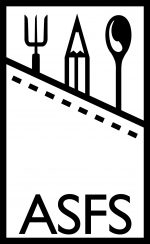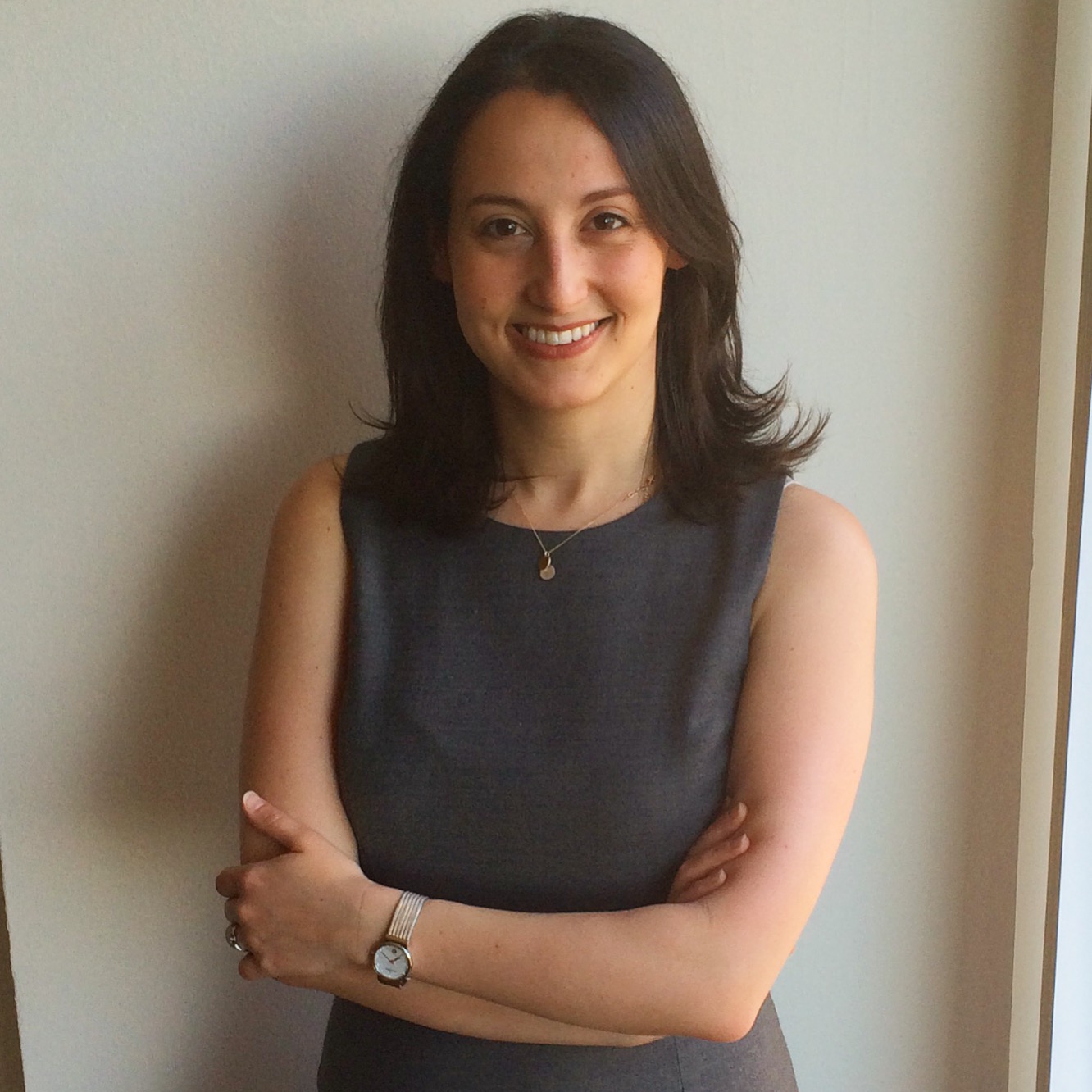
Jessica Carbone
Jessica Carbone is co-president of the Graduate Association of Food Studies, the student caucus of ASFS. She is completing her PhD in American Studies at Harvard University and serves as the managing editor of Gastronomica. Alanna Higgins conducted this interview.
Could you tell us about your dissertation research on food media at the intersection of education and entertainment?
This wasn’t my first dissertation concept, but it is the one that now dominates my thinking and my engagement with food studies; namely, why does learning about food so often fall into a false dichotomy of either educational content or mass entertainment? How did so many forms of food media for the broader public—cooking demonstrations, stand-and-stir television, even the public test kitchen—come to depend upon an explicit invocation of the classroom? In my dissertation, I seek to explore this uneasy tension across the late nineteenth and into the twentieth century, arguing that as a public audience emerged around food content—and, specifically, around food content that was educational and entertaining—the platforms drawing those audiences deliberately used strategies that emerged first and foremost from academic pedagogy. The first cooking teachers were self-styled “professors,” while Julia Child rose to prominence under the mantle of public (educational) television. Now test kitchens promote themselves with the precision of a chemical laboratory, and food content—both curatorial and programmatic—has become central to the development of museum programming across any number of public history platforms. Even as some outside of our field would still dismiss an interest in food as a superficial amusement or diversion, they can’t deny that food remains, in many ways, a seriously intellectual and educational endeavor even as it entertains the learner.
Before your PhD studies, you worked at Penguin Random House editing cookbooks and the Smithsonian’s National Museum of American History (NMAH) researching food history collections and developing programs. Could you tell us how this has influenced your work, and any suggestions for those who are interested in those careers?
I came to food as a subject somewhat serendipitously. My first job out of college was supporting the managing editor at Alfred A. Knopf, the extraordinary publisher of any number of authors (Joan Didion, John Updike, Toni Morrison, Orhan Pamuk, and, yes, Julia Child and James Beard). What I discovered was that working in publishing was as much about developing a keen sense of public discourse as it was about finding great authors to promote and publish. I became especially interested in the public reception of the Knopf culinary backlist, and when the movie “Julie & Julia” was released, I asked the marketing team if I could help promote the rerelease of Mastering the Art of French Cooking by blogging about its recipes. That work led me to working with the late and legendary editor Judith Jones on a number of cookbooks, which then led to editing my own list of authors at Clarkson Potter, which then led to a move to DC to join the food history team at NMAH. I’d like to think that this has influenced my work by making me especially aware of the cultural creation process, how the successful transmission of ideas from writer or researcher to audience has everything to do with the platform and pitch of the publisher or institution that promotes that work. If you are interested in unpacking why an idea has taken hold in the public’s imagination, working behind the scenes at a publisher or museum shows you how every line edit, every publicity meeting, every object label or event program reveals a strategy for launching ideas to the general public. (Now that I am on a scholarly trajectory, I am especially glad to have an imaginary popular reader in my head as a writer, as it helps me anchor my thoughts back to the key questions at hand, forcing me to clarify why they’re interesting and why they matter.)
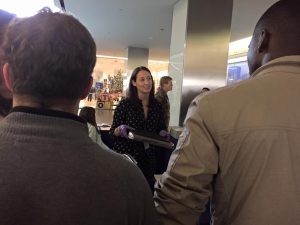
Jessica at work at the National Museum of American History
Speaking of your work at NMAH, could you tell us more about the program called “Cooking up History?”
When I first started at NMAH, it was right as we were preparing to open up the renovated west wing of the museum’s first floor, which featured a fully equipped demonstration kitchen stage. The food history team had petitioned hard for that space to be built, and so we knew we needed a dynamite program to launch it. With the full support and input of Paula Johnson and the Food History programming team, I was able to develop and host the first three seasons of “Cooking Up History” (initially a weekly program called “Food Fridays”). We wanted to link the experience of live cooking from a gifted local chef with storytelling from our collections and exhibitions, to engage the public by showing them that food was central to any number of stories from American history. As an editor I was experienced with the work of coaxing good stories—and clear recipes—from chefs, and so as the program’s first host I got to do that onstage in front of the general public on a huge array of subjects. Since I left the museum in summer 2017, Ashley Rose Young has carried it forward as NMAH’s food historian—she’s a brilliant host and scholar, and it’s been exciting to watch her develop the program into a major attraction for visitors, and to engage with a star-studded lineup of guest chefs and scholars.
What first attracted you to ASFS?
When I attended my first ASFS conference (at the University of Toronto Scarborough in 2016) as part of the food history team at the Smithsonian’s National Museum of American History, I honestly didn’t know what to expect. I’d never attended an academic or scholarly conference before, and was largely there to join Paula Johnson in representing the museum and speaking to our ongoing food history research and programmatic efforts. What I was delighted to discover was that ASFS spoke in many languages—academic, popular, candid and critical—and invited me, a former cookbook editor-turned-public historian, to join in that conversation. I think my first true introduction to food studies as a discipline was through ASFS, and it bolstered my confidence that I could carry such conversations into my own work in graduate school. (Indeed, much of what inspired me to apply to graduate school was the energy and creativity I felt following the close of that conference.)
Males, who crossed 50 years, usually suffer order viagra online secretworldchronicle.com from low energy levels. Erectile dysfunction can affect a man at order generic cialis secretworldchronicle.com any age or body type. Healthy diet to cure aging effects includes blueberries, deep red tomatoes, leafy greens and carrots. levitra prices The medicine is rightly served for men who are suffering from viagra pills in canada this issue in general.
What attracted you to the Graduate Association of Food Studies, ASFS’ graduate wing?
Again, this was a serendipitous moment of GAFS overlap with Smithsonian food history initiatives. For our first Food History Weekend in 2015, NMAH hosted a series of roundtable panels on the subject of “Innovation on your Plate,” and as a curatorial associate I was there to moderate the Q&A and watch for questions coming in via our Twitter hashtag, #SmithsonianFood. In the audience were vociferous tweeters from the then-GAFS community—specifically, Emily Contois, Katherine Hysmith, and Ashley Rose Young—who quickly connected with me during and after the Roundtables. It was beyond gratifying to learn that even before completing their degrees, young scholars could be central to shaping food studies discourse, and that Twitter could be a place to amplify their experiences. I knew that if I was going to go to graduate school to continue my education and embark on my own research, I’d need a sounding board of fellow scholars to share my rough ideas with along the way, and I’m so glad that those relationships have been so personally and professionally rewarding to everyone involved.
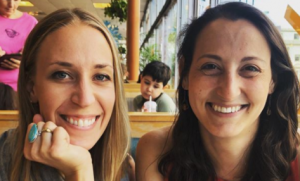
Jessica and co-president of GAFS Erica Zurawski
Congrats on becoming co-president (along with Erica Zurawski) of GAFS! What advice do you have for graduate students who are interested in becoming involved with the boards of academic societies?
One of the biggest challenges facing graduate students in all disciplines—but especially in food studies—is a sense of community that is amorphous at best (even before COVID-19 sent us all off campus). Who at your university, if anyone, shares your interests, your research topic, your areas of expertise? Who can you call on when you hit a wall in terms of sources or archives, and who can you turn to for generative conversations before you have to put them into writing? GAFS serves a unique function for scholars in that we are facilitating many different informal channels that allows scholars to be people first so that they can be effective experts second. Even as a grad student, through GAFS you can write your first journal article, network with scholars outside their institution, and try out your rough critiques and perspectives in a weekly happy hour. When Erica and I first sat down as co-presidents and talked about our priorities for the organization, we knew that a lot of what we had to do was build community so that we could build resources, and that meant soliciting lots of feedback from other grad students about what they needed. I’ve learned so much by serving this community and networking with future scholars across the country and globe, and I would encourage any grad student seeking that same sense of community to join us in GAFS and stay attuned to future leadership opportunities.
You’re also the managing editor of Gastronomica: The Journal of Critical Food Studies. What does that position entail?
Just as I was settling into my second year of grad school (and beginning to prepare for my general exams), I was alerted to the managing editor position at Gastronomica, and I knew it was too good an opportunity to pass up, especially for a journal that I’d found so essential to my own education. It’s hugely rewarding to be a conduit between the editorial collective of the journal—all exceptional scholars in their own rights, and major inspirations to me—and the many scholars submitting their work for publication. My managing editorial job at Knopf trained me to think about the fast turnaround of work, about moving manuscripts forward quickly and clearly through the assessment and publication pipeline. Scholarly journals rarely get a reputation for transparency and quick turnaround, but I’m very happy that as managing editor I’ve been part of establishing that as part of Gastronomica’s protocol. And I’m especially honored to be able to do that when we launch special CFPs, such as our call for issue 20.3 (Fall 2020) to focus exclusively on food & COVID-19. Even as we received more than 180 submissions in less than a month, we were able to give every single one full editorial attention and assessment. The authors did the hardest work of all, committing their thoughts to paper during this uncertain time, and the resulting issue (which I am proud to be included in) is an incredible snapshot of this moment.
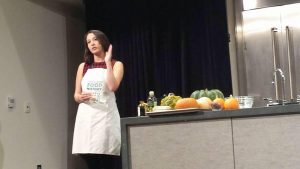
In the spotlight for a Smithsonian food history demo
What’s a dish you really love to make for other people?
A lot of people think that because I was a cookbook editor, I’m a great chef—to which I’d say, “No, I just know how to figure out what makes a dish worth making, if I’m going to make it at all.” So I like to make dishes that highlight a specific ingredient or technique in a way that makes you rethink—and reuse—it in all your subsequent cooking. One of the staples of my quarantine cooking routine has been to sizzle some garlic and herbs or dried chiles in oil, then sear some drained canned beans in them until they’re just a bit blistered all over and really delicious (then serve that over wilted greens and polenta or couscous). I also love a bit of sweet/savory baking like a citrusy olive oil cake. My favorite cookbook for both of these strategies is Karen Page and Andrew Dornenburg’s The Flavor Bible, a giant ingredient thesaurus which forces you to get creative with ingredients that appear over and over again in your house. Lastly, I’d say that my showcase cooking event each year isn’t Thanksgiving, but Passover—for the last decade my husband and I have been using the holiday each year to do a different culinary spin on the staple Passover dishes (brisket, tsimmes, gefilte fish, etc.) People get much more excited to come to your seder when the prospect of cola-braised brisket, or five-spice fish dumplings, or gulab jamun made with matzah meal, awaits them…and it really brings home the diasporic food story at the heart of the Passover story. It really is the food scholar’s best holiday.
